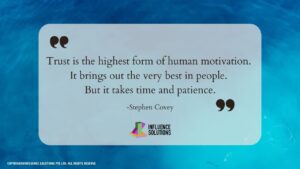Happy March!
To support you in being F.I.R.S.T. (Future-Ready. Innovative. Relevant. Strategic. Trusted.), here’s 1 tip and 1 quote.
The F.I.R.S.T. Tip
Trust isn’t always shattered in a single moment. More often, it erodes quietly through small disappointments, miscommunication, or unmet expectations. Once trust is broken, it can undermine productivity, morale, collaboration and even mental wellbeing.
So, how can you tell if trust is fading? And more importantly—what can you do about it?
Three Signs of Broken Trust & How to Address Them
1. Conversations Become Surface-Level or Avoidant
The Sign: People stop sharing openly, meetings feel tense, and difficult conversations are avoided. Instead of problem-solving together, team members work around each other.
How to Fix It: Research from Harvard Business Review suggests that psychological safety—the belief that one can speak up without fear of embarrassment or punishment—is key to high-trust environments. If conversations feel forced or superficial, take the first step:
Be transparent, acknowledge past tensions, and ask for input: “I feel like we’ve been holding back in our discussions. How can we make this a more open space?”
2. Increased Micromanagement or Lack of Delegation
The Sign: Leaders or colleagues start double-checking work excessively, hesitate to delegate, or insist on excessive oversight. This signals a lack of confidence in others’ abilities.
How to Fix It: Trust grows when expectations are clear and autonomy is respected. If micromanagement is creeping in, realign on expectations and create small winsto rebuild trust:
Set check-ins instead of constant oversight: “Let’s touch base mid-week so I can support where needed, but I trust your judgment on this.”
3. People “Check Out” Emotionally
The Sign: Low engagement, minimal participation in discussions, or a rise in passive-aggressive behaviour. This often means people don’t feel valued or safe enough to express their concerns or viewpoints.
How to Fix It: Research by Dr. Paul Zak, a neuroscientist found that employees in high-trust organisations report 74% less stress and 50% higher productivity. If you notice disengagement, rebuild trust through appreciation and inclusion:
Recognise contributions: “I really appreciate the effort you put into X. Your insights helped move the project forward.”
Create space for honest dialogue: Ask, “How are you feeling about our collaboration? What would help improve it?”
How Strong is Trust in Your Organisation?
Take a moment to assess your workplace trust levels. Our complimentary Trust Navigator survey helps you pinpoint where trust is thriving and where it might need rebuilding.
🔹 Take the Trust Navigator now to get a clear picture of trust within your team or organisation – https://analytics.influence-solutions.com/trust-navigator/
Trust issues rarely fix themselves. Spotting and addressing them early can prevent a downward spiral and lay the foundation for stronger, more resilient relationships.
The F.I.R.S.T. Quote







